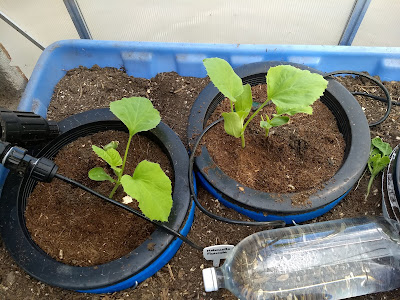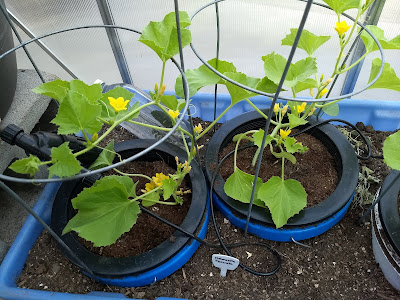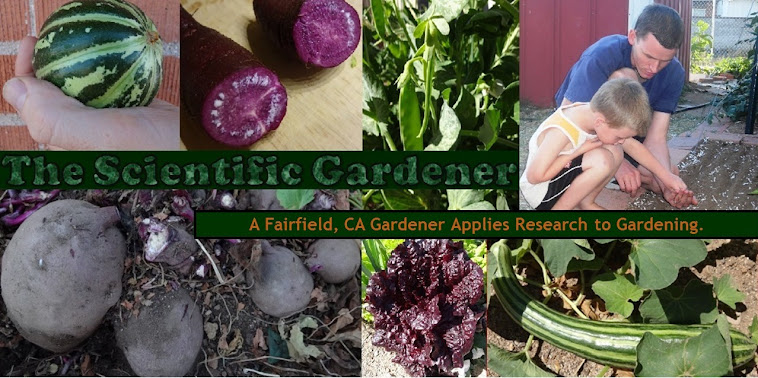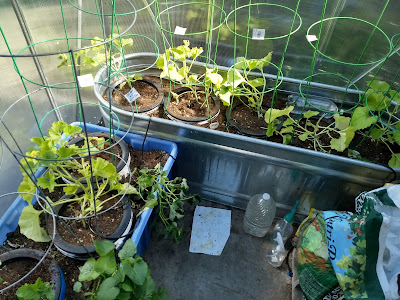To ensure acceptable consistency and marketability in fruit production, conscientious seed savers must work to select fruit and plants that express desirable traits in order to ensure that these traits continue to be expressed in further generations. Though a small amount of variation is generally accepted by gardeners and farmers that work with open-pollinated varieties, variability in multiple areas of plant and fruit growth as well as in fruit quality can make the seed less valuable.
 |
| Medium Long of Tarantino sprouting on March 19th, 2019. |
 |
| March 23rd |
 |
| March 26th |
 |
| April 1st |
 |
| April 10th |
 |
| April 11th |
One
vegetable variety I have been working to reduce the variation in is a
C. melo carosello variety I referred to as “Meloncella Fasciata” last
summer. As you may recall, I was super excited about what I termed the
banded Meloncella. Though the second grow-out I did with this variety
turned out to be all round (just like the Tondo Massafra in appearance) I
was able to save seed of the oval fruit I had grown. From this point
on, I will refer to this variety as the Carosello Tarantino. When saving seed for a specific trait, it is
important to remember the variability of the original population. The
traits that were expressed during all my grow-outs of the Medium Long of
Tarantino up to now included fruit shape (cylindrical or round) and
fruit color (solid striped or blotchy). When I refer to blotchiness, I
mean that the outer dark stripes are interrupted with patches of
light-colored flesh. While I saw some blotched fruit at the beginning of
growing out this variety, I wasn’t worried about blotchiness being a
significant trait because I saw minimal blotchiness on the fruit I
saved. However, because all of the second grow-out from 2018 was round,
fruit shape would be a major factor to isolate.
 |
| April 25th |
 |
| April 29th |
 |
| April 30th |
 |
| May 1st |
Before
saving seed for this variety last year, I sorted the fruit based on
their shape. The most oval fruit was sorted as an A and the most round
fruit ended up near the letter E. Although I would normally have picked
A, I felt that I should plant seed from the fruit that was labeled “B”.
 |
| Progression of Fruit - May 1st |
 |
| Progression of fruit, May 8th |
 |
| Fruit Progress - May 13th |
Because
all of the fruit that I grew from the parent plant was initially
cylindrical, I knew that my chances of getting cylindrical fruit was at
least 50 percent. I decided to dedicate two hydroponic baskets with my
reservoir buckets to this variety. One of the baskets had an EasyOlla
while the other did not. I figured that the one closest to the
greenhouse door would be the easiest to hand-water.
 |
| Second plant, May 1st |
 |
| May 9th |
Since
last year’s fruit had produced very healthy seed, the seedlings that
grew from them were very vigorous. I let the plants do their thing and
culled any plants that grew poorly in the soil. Sure enough, one pot
produced round fruit. Though the fruit was tasty, that was not what I
wanted. Instead of waiting around to see if it would produce more
cylindrical fruit the second time around, I pulled the round-fruited
vine to reserve more light for its neighbor.
 |
| May 14th |
 |
| May 14th |
 |
| May 15th |
 |
| May 17th |
As
all of the greenhouse plants grew, the cylindrical fruiting Medium Long
of Tarantino plant – which happened to be the one closest to the
greenhouse door – performed much better than the other plants. I believe
that much of this is related to overwatering the EasyOlla overwatering
some plants.
 |
| May 20th |
 |
| May 24th |
 |
| May 26th |
I’m very grateful that the one plant I needed to get seed
from the most was not affected by this mistake. One of the things I
appreciate most about growing in the greenhouse is that I can isolate
individual plants in order to ensure that there is no cross pollination.
Without a physical deterrent, bees would normally cross-pollinate my
cucumber-melons, making it extremely difficult for me to select for a
specific trait. When growing in the greenhouse, I hand-pollinate each of
my female flowers with male flowers on the same plant. In some plants,
such as corn, this would cause a problem known as inbreeding depression.
Though inbreeding C. melo is not the best practice for long-term seed
health, the vigor of C. melo seed saved from inbreeding is very high.
 |
| June 11th |
 |
| June 27th |
 |
| June 29th, fruit is soft and ready to harvest |
Close to the end of the growing-out of this variety I made a few major mistakes. One was that I overwatered the plant enough that all but one of the fruit on the vine aborted. I am grateful for the one fruit that I was able to save seed from, because it enabled me to take advantage of the isolation required to select cylindrical fruit for my next grow out in the garden.
On one final note: Here is a video of this variety when it was flowering. They are quite impressive in their female flower production at this stage.





























































